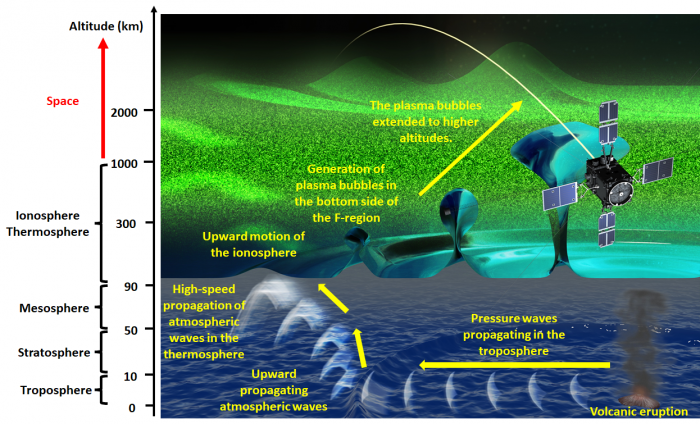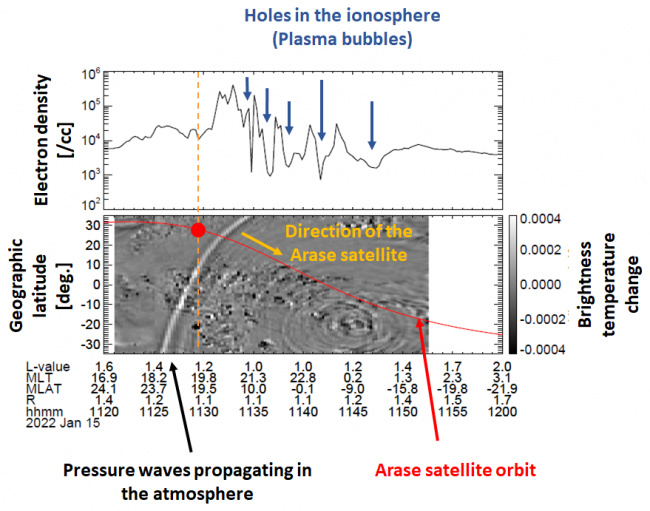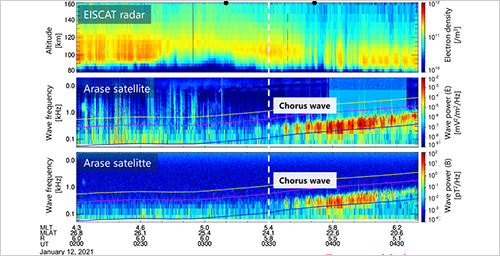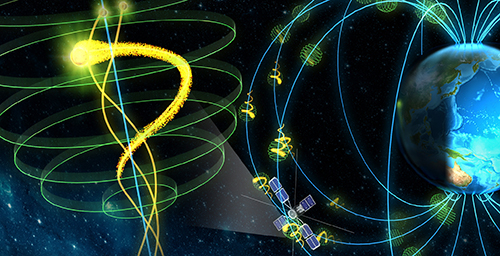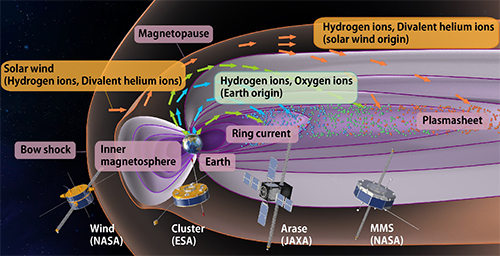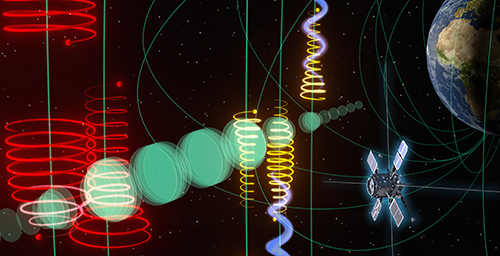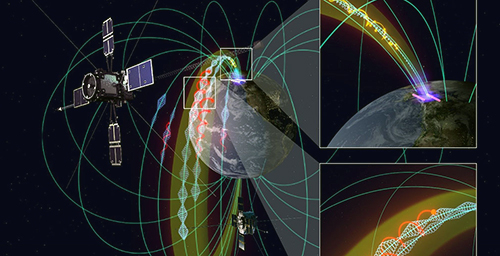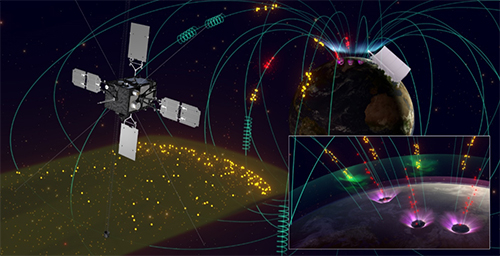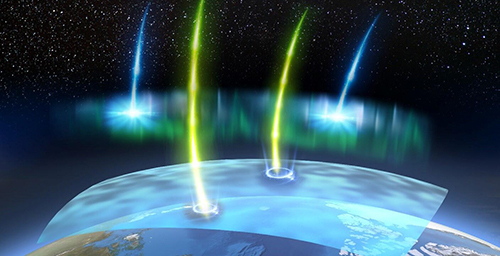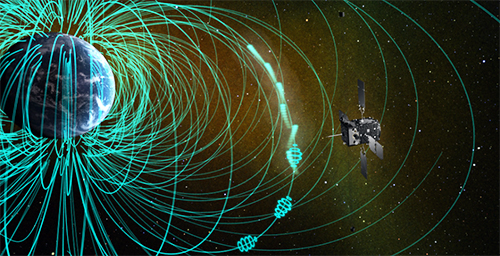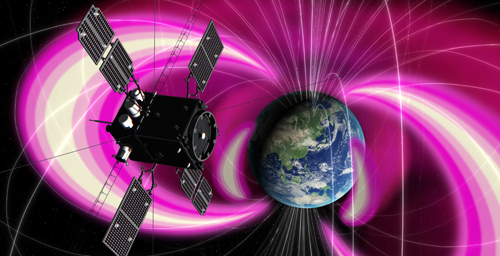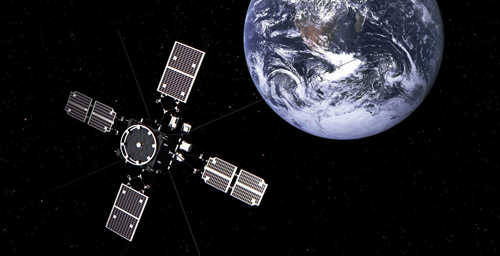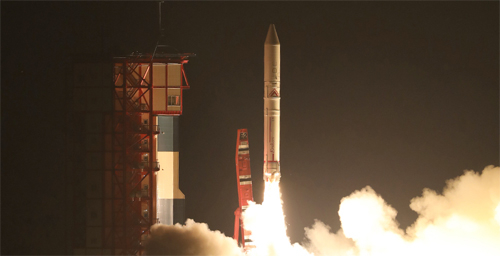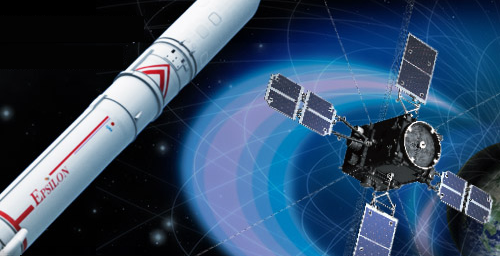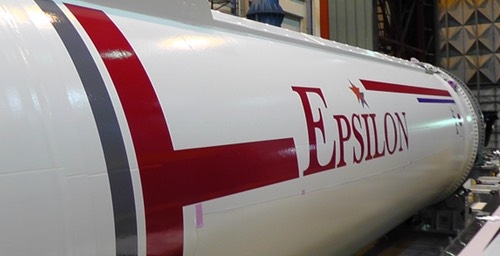Abstract
The explosive eruption of the undersea volcano "Hunga Tonga-Hunga Haʻapai" (hereafter "Tonga volcano") off the coast of Tonga in the South Pacific on 15 January 2022, was a cataclysmic event, with ash plumes reaching an altitude of 57 km, the highest in recorded history. Recent ground-based and satellite observations have revealed that the eruption affected the upper atmosphere, including the thermosphere and ionosphere. So how far did the influence of the volcanic eruption reach? A joint research group led by Designated Assistant Professor Shinbori Atsuki (Institute for Space-Earth Environmental Research, Nagoya University) has analyzed observation data obtained from the Exploration of energization and Radiation in Geospace (ERG) satellite, nicknamed "Arase," that was launched by the Japan Aerospace Exploration Agency. The research group was able to follow the development process of plasma bubbles (holes in the ionosphere) caused by large-scale atmospheric disturbances associated with the Tonga volcanic eruption. The group also found that plasma bubbles can reach space at an altitude of at least 2,000 km beyond the topside of the Earth's atmosphere. This finding is surprising because plasma bubbles were previously thought to be a phenomenon confined to the ionosphere. Plasma bubbles are one of the most important phenomena in space weather research because they severely affect satellite positioning and communications. Therefore, our results suggest that it is necessary to include the volcanic eruptions which cause large-scale atmospheric disturbances in the targets of space weather research.
The results of the present study were published in Scientific Reports, a comprehensive international journal published by Nature Research, on 22 May 2023.
1. Background
Plasma bubbles are "holes in the ionosphere" that occur in the ionosphere (the uppermost layer of the Earth's atmosphere) near the magnetic equator, where the electron density drops by two orders of magnitude compared to that in the surrounding area. The phenomena occur after sunset in the ionosphere, and the electron density cavity extends not only vertically in height, but also in the north-south direction within the ionosphere along magnetic field lines. Previous studies have shown that plasma bubbles occur more frequently during magnetic storms caused by solar surface phenomena, and during periods of solar activity maxima. The spatially disturbed electron density structure inside plasma bubbles severely affects satellite positioning and communications. Therefore, predicting and forecasting when and where plasma bubbles occur is one of the important issues in space weather research.
On the other hand, other previous studies have pointed out that atmospheric perturbations (atmospheric waves) propagating from the lower atmosphere are involved in generating plasma bubbles. However, observing the lower mesosphere and thermosphere at altitudes of 60-150 km is difficult, which is the path of atmospheric waves. No definitive observations have previously indicated plasma bubbles' generation and development through lower atmosphere perturbations.
On 15 January 2022, the explosive eruption of the Tonga volcano, which is said to occur once every 1,000 years, caused a powerful shock wave and pressure wave all over the world, and the pressure wave generated a high-speed tsunami. Ionospheric observations have confirmed that the eruption's influence penetrated the troposphere and stratosphere to reach the ionosphere at the top of the atmosphere. Further, the eruption caused a plasma bubble in the equatorial ionosphere. In this research, we attempted to verify the generation mechanism of plasma bubbles by observationally following the subsequent development of plasma bubbles starting from disturbances in the lower atmosphere associated with the volcanic eruption.
The Arase satellite, launched in December 2016, was placed into an elliptical orbit with a perigee of 400 km, apogee of 32,000 km, and an orbital period of 570 minutes to observe near-Earth geospace environmental variations. Arase has continuously conducted a wide range of plasma and electromagnetic fields from late March 2017 to the present. The Arase satellite is designed to observe electron density throughout the region from the ionosphere to near-Earth space with high precision and high temporal resolution. It is essential for studying the connection between the atmosphere and the cosmosphere.
When the observation status of the Arase satellite was investigated during the explosive eruption of the Tonga volcano, it was found that the satellite passed through the ionosphere after sunset, where plasma bubbles are frequently observed. Arase encountered the pressure waves associated with the volcanic eruption. Because Arase moves with high velocity near the perigee, the satellite has quite a short time for "in-situ" observations in the low altitude region (compared to its orbital period of about 570 minutes, observation time at an altitude of less than 2,000 km is less than 30 minutes). Despite such challenging observation conditions, Arase could observe the plasma bubble in latitude, longitude, and altitude just in time for the explosive eruption of the Tonga volcano.
2. Results
A detailed investigation of electron density data obtained from the Arase satellite confirmed that plasma bubbles were generated at ionospheric altitudes (400-1,000 km) by the explosive eruption of the Tonga volcano. Further, we discovered for the first time in the world that the plasma bubble structure extends from the ionosphere to space (about 2,000 km). By comparing the results with other ground-based observation data, we could observationally follow the generation and growth of the plasma bubble that appeared after the explosive eruption of the Tonga volcano (Figure 1). Specifically, the pressure waves associated with the eruption of the Tonga volcano caused atmospheric disturbances that propagated upward, triggering the generation of plasma bubbles in the ionosphere. The Tonga volcanic eruption was larger than usual and generated intense pressure waves that extended to space beyond the atmosphere. A detailed description of the research leading to this conclusion can be found in the Nagoya University press release.
Figure 1. Schematic view of plasma bubble generation mechanism observed after the Tonga volcano eruption. The vertical axis on the left represents the altitude, and the values and scales indicate the altitudes at the boundaries of each atmospheric layer. (© ERG science team)
Figure 2. Pressure waves and plasma bubbles were observed after the eruption of the Tonga volcano. The upper panel is a time-series plot of the electron density variation observed by the Arase satellite. The lower panel is a latitude-time plot of the infrared brightness temperature along the satellite's longitude. The parameters at the bottom of the figure indicate the time and position of the Arase satellite. (© Modified from Shinbori et al., 2023)
Figure 2 shows the observation data of the Arase satellite on the day of the Tonga volcanic eruption. As shown in the lower panel of figure 2, Arase encountered the pressure waves associated with the eruption of the Tonga volcano near the perigee (altitude 400 km) in the early evening and then flew into space. The time-series plot of electron density in the upper panel of figure 2 shows that a sharp increase in electron density occurred a few minutes before the Arase satellite encountered the pressure wave and that the plasma bubbles were observed as a sharp decrease in the electron density by one to two orders of magnitude, compared to the electron density in the surrounding area (the blue arrows in the figure indicate these points). This observation suggests that the plasma bubbles extended to space at an altitude of 2,000 km beyond the top of the ionosphere (1,000 km). This is the first direct observation of a plasma bubble in space at an altitude of more than 1,000 km and the first identification of a plasma bubble reaching into space.
3. Scientific and social significance and future perspective
Previous studies have indicated that disturbances in the lower atmosphere can generate plasma bubbles. However, the absence of definitive observations did not reveal whether lower atmospheric disturbances are truly responsible for generating plasma bubbles. The Arase satellite observation could observe the development process of plasma bubbles caused by large-scale atmospheric disturbances associated with the Tonga volcanic eruption and demonstrated that disturbances in the lower atmosphere could generate plasma bubbles. In addition, we found that plasma bubbles are a phenomenon that can reach space beyond the atmosphere. While it is regarded that solar activity is the leading cause of plasma bubbles, the present study was a unique case study in that a large-scale atmospheric disturbance associated with a volcanic eruption led to the development of plasma bubbles. This result is a direct observation to demonstrate the formation process of plasma bubbles through the disturbances in the lower atmosphere, which had little observational support until now. It will greatly help in understanding the factors involved in generating ordinary plasma bubbles. The detailed physical process for plasma bubbles to reach space should be studied in the future as a new direction of geoscience research on the effect of the Earth's impact on space that has been overlooked.
Plasma bubbles are one of the most important phenomena in space weather research because they severely affect satellite positioning and communications. The observational fact that the Arase satellite captured plasma bubbles generated by a large-scale volcanic eruption suggests that space weather research, focusing on the mechanism and forecast of plasma bubbles generated by solar activity, should also include natural phenomena occurring on the Earth's surface, such as volcanic eruptions, in the research targets.
Applying the findings obtained in this study to planets and satellites with active volcanos will also help develop a new paradigm in heliospheric science for changes in the space environment that occur due to volcanic eruptions on the ground. For example, Venus is covered by thick clouds, and it is difficult to directly determine the presence or absence of active volcanoes only by optical observations by satellites. The presence of active volcanoes may be confirmed by plasma measurements like those made by the Arase satellite. To this end, it is important to continue satellite observations on the Earth and planets, as was accomplished by the Arase satellite, and collaboration among a wide range of research fields, including volcanology, meteorology, upper atmosphere, and plasma physics, will be necessary to deeply understand the connection between the Earth, planets, and space in the future.
Glossary:
Thermosphere: A region in the atmosphere where the temperature increases with altitude. Temperatures reach 1,000 to 2,000°C around 600 km. The thermosphere is a region at about 90 to 1,000 km altitude.
Ionosphere: A region where ultraviolet rays and X-rays from the Sun ionize molecules and atoms in the upper atmosphere surrounding the Earth. This region absorbs, refracts, and reflects radio waves, affecting shortwave propagation and other radio waves.
Geospace: The near-Earth space where is becoming a human activity zone.
Space Weather: Changes in the near-Earth space environment caused by solar activity. Phenomena that cause certain conditions of space weather are called space weather phenomena. They are solar-related phenomena such as solar flares, coronal mass ejections, and coronal holes as a source of high-speed solar wind.
Magnetic storms: A phenomenon in which the horizontal component of the geomagnetic field decreases globally at mid- and low latitudes. In a typical magnetic storm, the geomagnetic field decreases over several hours to a day and then gradually recovers its original strength over several days.
Troposphere: The lowest region of the vertical structure of the Earth's atmosphere. In the troposphere, active convection causes many meteorological phenomena.
Stratosphere: The Earth's atmosphere between the troposphere and mesosphere. The stratosphere is a region of high ozone concentration, which absorbs ultraviolet radiation.
Pressure Waves: Waves traveling through the atmosphere with pressure fluctuations caused by air oscillations from eruptions and explosions.
Mesosphere: The Earth's atmosphere between the stratosphere and the thermosphere. In the mesosphere, temperatures decrease with altitude.
Paper Information:
Journal: Scientific Reports (Nature Research)
Title: Generation of equatorial plasma bubble after the 2022 Tonga volcanic eruption
Authors:
Atsuki Shinbori, Institute for Space-Earth Environmental Research, Nagoya University, Designated Assistant Professor
Takuya Sori, Institute for Space-Earth Environmental Research, Nagoya University, Designated Assistant Professor
Yuichi Otsuka, Institute for Space-Earth Environmental Research, Nagoya University, Associate Professor
Michi Nishioka, Radio Research Institute, National Institute of Information and Communications Technology, Principal Researcher
Perwitasari Septi, Radio Research Institute, National Institute of Information and Communications Technology, Researcher
Takuo Tsuda, Graduate School of Informatics and Engineering, The University of Electro-Communications, Associate Professor
Atsushi Kumamoto, Graduate School of Science, Tohoku University, Associate Professor
Fuminori Tsuchiya, Planetary Plasma and Atmospheric Research Center, Tohoku University, Professor
Shoya Matsuda, Graduate School of Natural Science and Technology, Kanazawa University, Associate Professor
Yoshiya Kasahara, Graduate School of Natural Science and Technology, Kanazawa University, Professor
Ayako Matsuoka, Word Data Center for Geomagnetism, Graduate School of Science, Kyoto University, Professor
Satoko Nakamura, Institute for Space-Earth Environmental Research, Nagoya University, Designated Associate Professor
Yoshizumi Miyoshi, Institute for Space-Earth Environmental Research, Nagoya University, Professor
Iku Shinohara, Institute of Space and Astronautical Science, Japan Aerospace Exploration Agency, Professor

